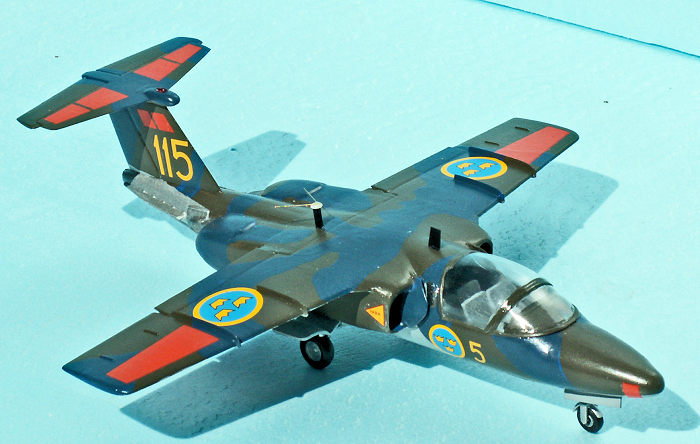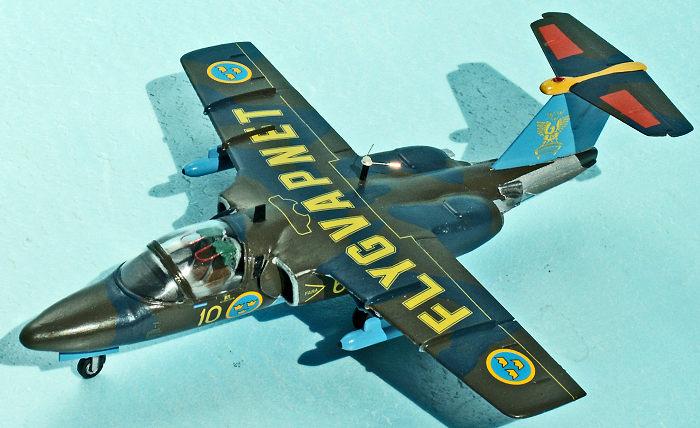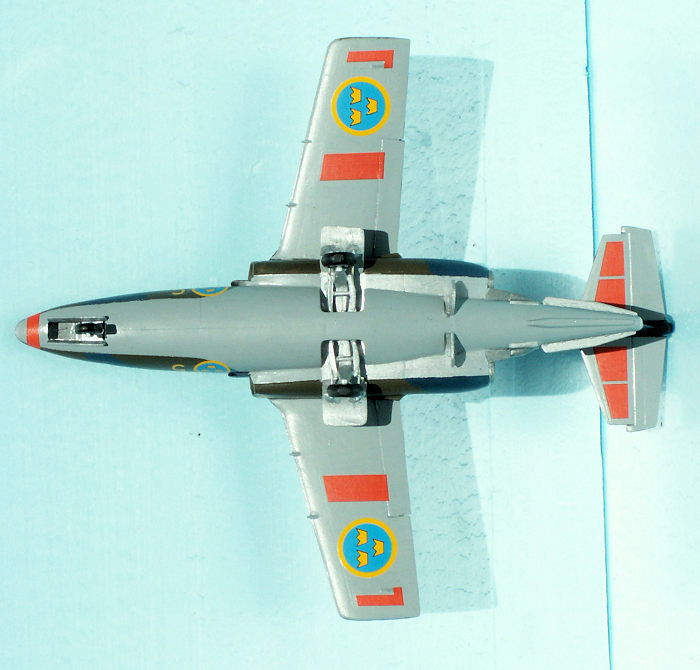
| KIT #: | 2 |
| PRICE: | $27.00 |
| DECALS: | Five options |
| REVIEWER: | Torben Plesberg |
| NOTES: | short run kit |

| HISTORY |
When the Vampire J 28 C needed a replacement, the SAAB company designed a high wing twin engine side by side training aircraft. The new plane got the designation SAAB 105. The prototype flew for the first time in 1963, and four years later the SK 60 was in service with the F 5, the aviation school of the Swedish Air Force, Flygvapnet.
The SK 60 was powered by license built Turbomeca Aubisque turbofans under the designation RM 9 or RM 9 B. These engines were later replaced by more modern Williams International FJ 44 – RM 15. Some aircraft were powered by General Electric J 85 engines, which offered a slightly better performance. However, the export version SAAB 105 OE for the Austrian Luftwaffe had the 2850 lbf J 85 engine, which boosted the performance further. The rate of climb was 180 % better than that of the SK 60 with the 2090 lbf J 85.
 The SK 60 was built in a number of
150 for Flygvapnet. A further forty planes were built for the Austrian armed
forces. Only two prototypes were built. One of these was modified a couple of
times as an export demonstrator, the SAAB 105 XT. A revised version of the XT
was called 105 G. Other projects were the 105 D, a business jet variant with 5
seats, and the 105 H, a proposed variant for the Swiss Air Force. However, none
of these projects materialized.
The SK 60 was built in a number of
150 for Flygvapnet. A further forty planes were built for the Austrian armed
forces. Only two prototypes were built. One of these was modified a couple of
times as an export demonstrator, the SAAB 105 XT. A revised version of the XT
was called 105 G. Other projects were the 105 D, a business jet variant with 5
seats, and the 105 H, a proposed variant for the Swiss Air Force. However, none
of these projects materialized.
In 1993 an upgrade program was initiated to modernize the SK 60. Most important was a new engine installation. The old Turbomeca Aubisque and GE J-85 engines were replaced by Williams FJ 44 turbofans, which offered more thrust, less noise, less dirt and easier maintenance. The upgraded aircraft got the designation SK 60 W. 115 aircraft were upgraded, and the rest of the 150 aircraft, mostly the D and E variants were grounded, and used for spares.
At present time 72 SK 60 W are still in service with Flygvapnet, however, a successor is getting more and more relevant. The F 5 Flying School was formed in 1926, and disbanded in 1998. During the 72 years of operation, 5345 pilots got their wings – 5344 men and 1 woman! She was Anna Matlinger, and became the first female J 37 Viggen pilot, and later the first female JAS 39 Gripen pilot.
| THE KIT |
This is just the second kit release from Marivox, the first one being the J 22 WWII fighter plane. It is a short run kit and comes in a small box with a low flying SK 60 on the lid and color illustrations of the five options of the kit in the bottom.
There are two sprues in white
styrene and a clear sprue with the transparent parts. The Sprues are rather
thick, the sprue gates are often very short, which makes it difficult to
separate the parts from the sprues without breaking them. Some of the parts for
the main undercarriage legs are almost impossible to separate from the sprue
without damage – alternative parts must eventually be made! This is a flaw of
the kit, meaning: it is not for beginner s. There is some flash and several sink
marks. Before the construction, it is important to decide, which version you
want to build - there are four options! When your choice is done, it is a good
measure to remove all parts not needed for your model – to avoid confusion!
s. There is some flash and several sink
marks. Before the construction, it is important to decide, which version you
want to build - there are four options! When your choice is done, it is a good
measure to remove all parts not needed for your model – to avoid confusion!
The instructions is a folded A 3 sheet, making four A 4 pages. Page one is a brief history of the SAAB 105, including technical data. Pages two and three are a collection of exploded sketches, supposed to be of help during the construction. Not all questions are answered, especially how to assemble the engines properly. The undercarriage assembly is almost hopeless, and without photos of the real thing, you are lost. In short: the instructions are simply too bad! Page four gives color references to F.S., Humbrol and Xtra Color. However, some of the Humbrol colors are no longer in the range (108 and 134).
An upgraded kit was released, with new decals and a fret of photo- etched parts. There is a folded A 3 sheet with a nicely printed color guide and stenciled instructions. An aircraft from Team 60, the Swedish official aerobatic team, is shown from above, below and both sides. There is a complete set of decals for this aircraft. Three Austrian SAAB 105 Ö are shown, one of them in “Tiger color scheme” as shown at the Malta International Airshow in 1998. The numerous stripes of the tiger, however, are not included with the decal sheet. This upgraded kit is a better buy than the original kit! The Team 60 aircraft is the subject of one of my models.
| CONSTRUCTION |
I decided for a SK 60
D, the four seat liaison and transport version of Flygvapnet. The first problem
was that the two small windows in front of the engine air intakes did not fit to
the openings in the fuselage halves. It was quite a job to correct these
openings! The other problem was nose weight, a problem not dealt with in the
instructions. I figured out that if I filled the nose (part 40) with lead, this
would probably be enough to avoid
 tail sitting. This proved to be right. Lead is
best fixed to the styrene with white glue. This does not soften the styrene, and
when dry, it makes a very tough coat keeping the lead in place.
tail sitting. This proved to be right. Lead is
best fixed to the styrene with white glue. This does not soften the styrene, and
when dry, it makes a very tough coat keeping the lead in place.
Some of the parts must be sanded for a better fit: 19 + 20 and 21 + 22 (reversers for the engines). Parts 8 + 9 should not be used, since they cannot be seen on the original aircraft. It is not a simple matter to assemble the sides of the engines, parts 15 +17 and 16 + 18 – and how part no 7 is glued in place, is completely up to you! The canopy parts do not fit properly, unless you sand the underside of the windscreen to fit with the fuselage. If you don’t do this, there will be a one mm gap between the fuselage and the windscreen!
 The main undercarriage legs must be
glued directly to the bottom of the fuselage, part no 48. This is not evident in
the instructions. If you don’t do so, the “sit” of the finished model will be
wrong! The cockpit has not much room in the height. There is definitely not room
enough for the ejection seats. That is why I choose the D version with four
simple seats – and because I have some photos of this version. This version is
unarmed, so I avoided possible problems with the armament under the wings.
The main undercarriage legs must be
glued directly to the bottom of the fuselage, part no 48. This is not evident in
the instructions. If you don’t do so, the “sit” of the finished model will be
wrong! The cockpit has not much room in the height. There is definitely not room
enough for the ejection seats. That is why I choose the D version with four
simple seats – and because I have some photos of this version. This version is
unarmed, so I avoided possible problems with the armament under the wings.
However, I also build a Team 60 aircraft from the upgraded kit. This model had the ejection seats, which had to be modified – i.e. made lower! The thickness of the hood is considerable out of scale, and there is not much room in the cockpit. I added the red ejection handles, since they can be seen from outside. The Team 60 aircraft have two pods with smoke generators under the wings. These had to be scratch built, since they were not with the kit. It was a lot easier to build the second model. I had learned some lessons from the building of the first one!
| COLORS & MARKINGS |
The SK 60 D
has the following camouflage painting scheme: under sides light grey, Revell
Hellgrau 76 Aqua, upper sides Revell Nato Olive 46 Aqua and a dark blue grey
color which was mixed by adding Revell 46 to Ultramarin Blue Revell 51 Aqua. The
blue grey color will do, when the blue is rather dull. The instructions suggests
HB 134, however, this color is no longer in the Humbrol range. HB 15 midnight
blue will do. There is a natural metal area behind the engines and touching the
bottom of the fin, Revell 99 aluminium Aqua. The jet
 exhaust is gun metal HB 53,
and likewise the reversers of the engines. Undercarriage legs and wheel wells
are natural metal, and tires are rubber black, Tamiya XF-85 acrylic.
exhaust is gun metal HB 53,
and likewise the reversers of the engines. Undercarriage legs and wheel wells
are natural metal, and tires are rubber black, Tamiya XF-85 acrylic.
The decals of the kit were applied, and these included the day glow areas of the wings and the underside of the nose. The individual number of the model is 115, however I don’t know for sure if this number was actually a D version. My aim was to do 143, which definitely was a D. My stock of decals was unfortunately not capable of delivering this number in the right size and color. The “FARA” (DANGER) markings at the engine air inlets are prominent and with the decal sheet of the kit. After decaling, the whole aircraft got a layer of Satin Cote to protect the decals and give a nice finish.
The SK 60 W of Team 60 is different
from a standard SK 60 of the F 5. The color scheme is the new one of the
resurrected aerobatic team, as it looks today. The undersides of the fuselage,
wing and fin are light blue, Revell 50 Aqua. The tai l plane and the stripes on
the underside of the wing are yellow, Revell 15 Aqua or HB 24 trainer yellow.
The undersides of the nacelles are natural metal behind the main gear doors. The
rest of the aircraft has the standard camouflage color scheme of an F 5
aircraft.
l plane and the stripes on
the underside of the wing are yellow, Revell 15 Aqua or HB 24 trainer yellow.
The undersides of the nacelles are natural metal behind the main gear doors. The
rest of the aircraft has the standard camouflage color scheme of an F 5
aircraft.
The decaling is special, dominated by the large FLYGVAPNET marking on the upper side of the wings. The fin has the badge of “Krigsflygskolan”, and there is a thin yellow line between the light blue and camouflaged areas on the fuselage in front of the air intakes. Since the F 5 was disbanded in 1998, the pilot training was transferred to the F 10, hence the “10” marking beneath the canopy. As individual marking, I choose no 3 = 61, because I have a photo of this aircraft from an open day at Ljungbyhed in 1986. It takes some care to apply the decals properly. They are rather fragile – especially the thin yellow lines on the wing and the front fuselage. The latter can only be applied properly, if the camouflaged area was painted after a template made after the thin yellow line as it appeared on the decal sheet. The application of the FLYGVAPNET marking was quite a challenge ! Fortunately, there was an extra “E”, which I had to use for my model, because the divided E by chance did not fit with the position of the other letters. The decals are well printed, however, a bit too thin. There are many very small yellow stencils, I did not apply any of these. The most difficult item of making a Team 60 SK 60 W is actually the decaling!
| CONCLUSIONS |
Conclusions: It was a challenge to build the Marivox 1/72 SAAB 105. I had to build this rather unique aircraft, because I have seen it in action so often, either as a solo demonstration, or the full aerobatic performance of the Team 60 – with classic music from the loudspeakers! It was not an easy build, however, I had the necessary photo documentation as a supplement to the not sufficient instructions. The kit is not recommended for beginners. Experienced modelers have an opportunity of getting a reasonable model of a truly special aircraft rarely seen outside Sweden and Austria.
| REFERENCES |
Björn Karlström: “Swedish Air Force trainers 1926-1997 in scale 1/72”p. 90-93. Allt om Hobby, Stockholm 1997. ISBN 91-85496-83-9
Wikipedia: articles on the SAAB 105 in English and Swedish.
My own photos of the SK 60, mostly taken in Sweden.
15 November 2019
Copyright ModelingMadness.com If you would like your product reviewed fairly and fairly quickly, please
contact
the editor or see other details in the
Note to
Contributors. Back to the Main Page
Back to the Review
Index Page
Back to the Previews Index Page